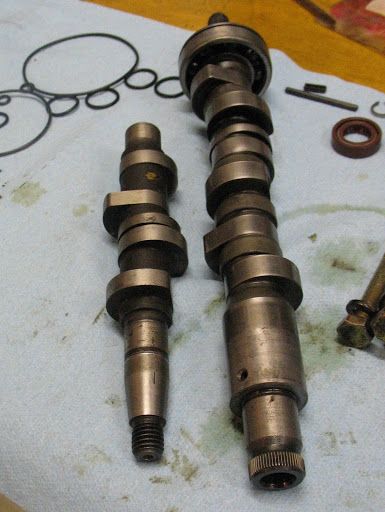 |
 |
 |
 |

|


|
|
|
|
|
|
#1
|
||||
|
||||
|
Why is turning the engine over counter clockwise bad?
This is a question coming from mere curiosity as I try to respect all of the warnings in the FSM and on this forum.
Why is turning the engine over counter clockwise very bad?
__________________
-Typos courtesy of my mobile phone. |
|
#2
|
||||
|
||||
|
Because the tensioners for the timing chain are set up to maintain tension in the proper direction. In the other direction, the tensioners can be compressed, and allow slack to build on the normally tensioned side. If there is enough slack, the chain can then skip a few teeth and your timing is lost. Too far, and you can have valves and pistons meeting up.
|
|
#3
|
|||
|
|||
|
The chain can not skip teeth if the engine is in proper order.
Later turbo engines have a ratcheting tensioner that eliminates the creation of slack on the drive side. Regardless, it should not be done more than a few degrees without the engine open. |
|
#4
|
|||
|
|||
|
the tensioner is not designed to take the load when turning backwards, it will work, but it is not a very robust design.
The vacuum pump is something that does not want to be driven backwards. The pivoting arm is designed to 'give' in one direction only. It will go backwards without issue, it's just not ideal. |
|
#5
|
|||
|
|||
|
The models without a ratcheting tensioner will not skip teeth either unless you apply so much torque that you start braking things.
On those models, the chain will bunch up, resist movement, then damage teeth etc.. |
|
#6
|
||||
|
||||
|
Quote:
__________________
-diesel is not just a fuel, its a way of life-  '15 GLK250 Bluetec 118k - mine - (OC-123,800) '17 Metris(VITO!) - 37k - wifes (OC-41k) '09 Sprinter 3500 Winnebago View - 62k (OC - 67k) '13 ML350 Bluetec - 95k - dad's (OC-98k) '01 SL500 - 103k(km) - dad's (OC-110,000km) '16 E400 4matic Sedan - 148k - Brothers (OC-155k) |
|
#7
|
|||
|
|||
|
Quote:
As I stated, it will go backwards without incident. The difference is like pushing a wheelbarrow over a large rock vs. pulling it over the same rock. It is different. And if you ran your engine backwards, the pump would not have even half the lifespan. |
|
#8
|
||||
|
||||
|
If I had to guess, I'd say that the problem with counter-rotating the engine is in the injection pump. If you look at the camshafts in these inline pumps, you'll see that the cam lobes have a very steep drop-off when the plungers are unsprung, so going backwards up that ramp is possible, but potentially problematic.
Here you can see OM615 and OM606 camshafts side by side: |
|
#9
|
|||
|
|||
|
I guess I forgot to answer the question.
The real danger is valve interference. Not by skipping teeth though. If the tensioner depressed when turning backwards, the number of chain links between the cam and crank are reduced. Or, more simply, the crank turns and the cam does not. Allowing the pistons to approach the stationary valves. |
|
#10
|
||||
|
||||
|
I believe that the forward face is the steep ramp on the IP.
__________________
Gone to the dark side - Jeff |
|
#11
|
||||
|
||||
|
As long as the Camshaft and Camshaft Bearing in the Fuel Injection Pump have lubrication rotating the Fuel Injection Pump Backwards will not harm the Fuel Injection Pump.
I have rotated Fuel Injection Pumps on the Test Stand the wrong way before quite a few times with no issues. While with Inline Fuel Injection Pumps rotating them the wrong way causes no problems is not the same with the Stanadyne (Roosamaster) or Bosch VW Rabbit type Fuel Injection pumps that have built in Vane type Fuel Supply Pumps that must be rotated in a specific direction. None of them will be damaged rotating them the wrong way if the Rotation is done by Hand and only for several revolutions of the Engine.
__________________
84 300D, 82 Volvo 244Gl Diesel |
|
#12
|
||||
|
||||
|
Answer
Quote:
* Tension must be fully loaded in the correct direction to determine/set base mechanical timing = backing up generates slack on the wrong side even with a new timing chain chain = you must rotate one full crankshaft revolution in the correct direction to guarantee chain loading. * Excess load on the timing chain tension rail (banana rail), breaking the plastic guide surface. * Defective/damaged timing chain tensioner ratchet failure = collapsing = chain slack = skipping teeth/timing loss = possible mechanical engine damage. * Lack of lubrication. Quote:
Thanks for the great picture.  .
__________________
ASE Master Mechanic https://whunter.carrd.co/ Prototype R&D/testing: Thermal & Aerodynamic System Engineering (TASE) Senior vehicle instrumentation technician. Noise Vibration and Harshness (NVH). Dynamometer. Heat exchanger durability. HV-A/C Climate Control. Vehicle build. Fleet Durability Technical Quality Auditor. Automotive Technical Writer 1985 300SD 1983 300D 2003 Volvo V70 https://www.boldegoist.com/ Last edited by whunter; 03-21-2013 at 08:44 PM. |
|
#13
|
||||
|
||||
|
Yes, assuming clockwise rotation. I've turned all of my VW/Mercedes diesels backwards and have not experienced any problems whatsoever.
|
|
#14
|
||||
|
||||
|
Hmm
Quote:
Some people are lucky, others do it once and damage/wreck the engine. The engine is yours, the final decision on how service is done is yours. |
|
#15
|
||||
|
||||
|
Recycled
for new members
|
 |
| Bookmarks |
|
|